Yin R. Metallurgical Process Engineering
Подождите немного. Документ загружается.


228
Metallurgical Process Engineering
5.54.5 4.8 5.0
Slab
casting
speed/m-mm'
tion is to heat up different kinds
of
slabslbillets and homogenize inside tempera-
ture
of
them, by putting in different energy resources and converting into thermal.
On account
of
high temperature
of
slabs exiting from high speed caster and the
development
of
hot conveying and hot charging technologies, the entry tempera-
ture
of
the slabs/billets into the reheating furnace has been increasing. For the thin
slab continuous casting-rolling process, the entry surface temperature
of
slabs into
the reheating furnace has been up to 1050-1080 °C (Fig. 8.3).
It is thus clear that
reheatingfurnace's heatingup functionhas been relativelyweakeningfor the near-net-
shape caster and high speed caster, meantimes, its function of recovering waste heat
andresidualenergyhas beengraduallyenhanced.
'"
~
1080
:; E1060 1055
~"a
1040
EO)
B
21020
'" E!
.s
'01000
5
tj
j i
::
jj 940'--.....".,,....-_---..,.'-:-
__
-:-':,....-_---::'-:-_---,:-':-----'
Fig. 8.3 Relationbetweencasting speedand slabsurfacetemperature
2. Buffering-coordinating equipment.
For
the continuous casting
-hot
rolling section, reheating furnace plays a role
of
linkage between different
temperature interval and different time rhythm. Its capacity and heating up
speed take the function
of
buffering and coordinating, on the continuation
and operation
of
the process. Particularly the tunnel reheating furnace is
long extended (for thin slabs, the tunnel furnace is as long as 180
-300
m,
and for billets or blooms, it is also as long as
over
120 m) and closely
linked with caster, its buffering coordinating function must be much higher,
as the requirement for process continuation is high.
It
has become an in-
creasingly significant task to give full play to the buffering-coordinating
function
of
the tunnel type reheating furnace.
3. Metal quality and performance controller. For a lot
of
steel
grades,
their
property and performance are directly related with slab/ billet cooling and heat-
ing-up processes, as in these courses the nucleation, growth, dissolution and pre-
cipitation
of
some particles take place in slabslbillets. The cooling and heating
processes affect phase transformation, particle separation, and grain sizes. There-
fore, the control
of
heating temperature and time length also impact the quality
and performance
of
many products. Furthermore, the control
of
atmosphere inside
the furnace and the control
of
temperature and time also impact the surface qual-
ity
of
steels. Obviously, the reheating furnace is an important controller for qual-
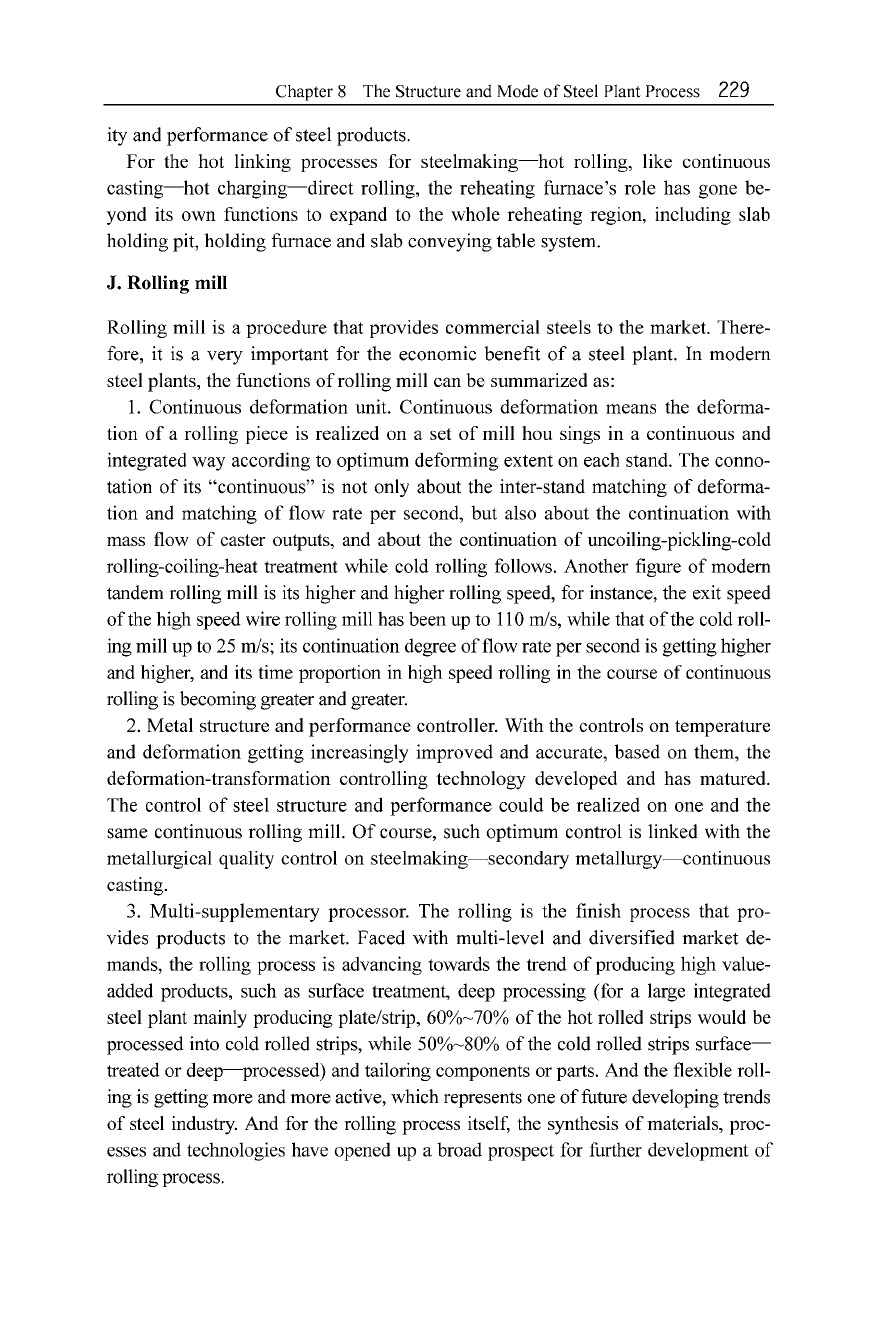
Chapter 8 The Structure and Mode
of
Steel Plant Process 229
ity and performance
of
steel products.
For the hot linking processes for steelmaking
-hot
rolling, like continuous
casting
-hot
charging
-direct
rolling, the reheating furnace's role has gone be-
yond its own functions to expand to the whole reheating region, including slab
holding pit, holding furnace and slab conveying table system.
J. Rolling mill
Rolling mill is a procedure that provides commercial steels to the market. There-
fore, it is a very important for the economic benefit
of
a steel plant. In modern
steel plants, the functions
of
rolling mill can be summarized as:
I. Continuous deformation unit. Continuous deformation means the deforma-
tion
of
a rolling piece is realized on a set
of
mill hou sings in a continuous and
integrated way according to optimum deforming extent on each stand. The conno-
tation
of
its "continuous" is not only about the inter-stand matching
of
defonna-
tion and matching
of
flow rate per second, but also about the continuation with
mass flow
of
caster outputs, and about the continuation
of
uncoiling-pickling-cold
rolling-coiling-heat treatment while cold rolling follows. Another figure
of
modem
tandem rolling mill is its higher and higher rolling speed, for instance, the exit speed
of the high speed wire rolling mill has been up to 110mis, while that
of
the cold roll-
ing mill up to 25 m/s; its continuation degree of flow rate per second is getting higher
and higher, and its time proportion in high speed rolling in the course
of
continuous
rolling is becominggreater and greater.
2. Metal structure and performance controller. With the controls on temperature
and deformation getting increasingly improved and accurate, based on them, the
deformation-transformation controlling technology developed and has matured.
The control
of
steel structure and performance could be realized on one and the
same continuous rolling mill.
Of
course, such optimum control is linked with the
metallurgical quality control on steelmaking-secondary metallurgy-continuous
casting.
3. Multi-supplementary processor. The rolling is the finish process that pro-
vides products to the market. Faced with multi-level and diversified market de-
mands, the rolling process is advancing towards the trend of producing high value-
added products, such as surface treatment, deep processing (for a large integrated
steel plant mainly producing plate/strip, 60%
-70%
of the hot rolled strips would be
processed into cold rolled strips, while 50%
-80%
of
the cold rolled strips surface-
treated or
deep-----processed)
and tailoring components or parts. And the flexible roll-
ing isgetting more and more active, which represents one
of
future developing trends
of steel industry. And for the rolling process itself, the synthesis
of
materials, proc-
esses and technologies have opened up a broad prospect for further development of
rolling process.
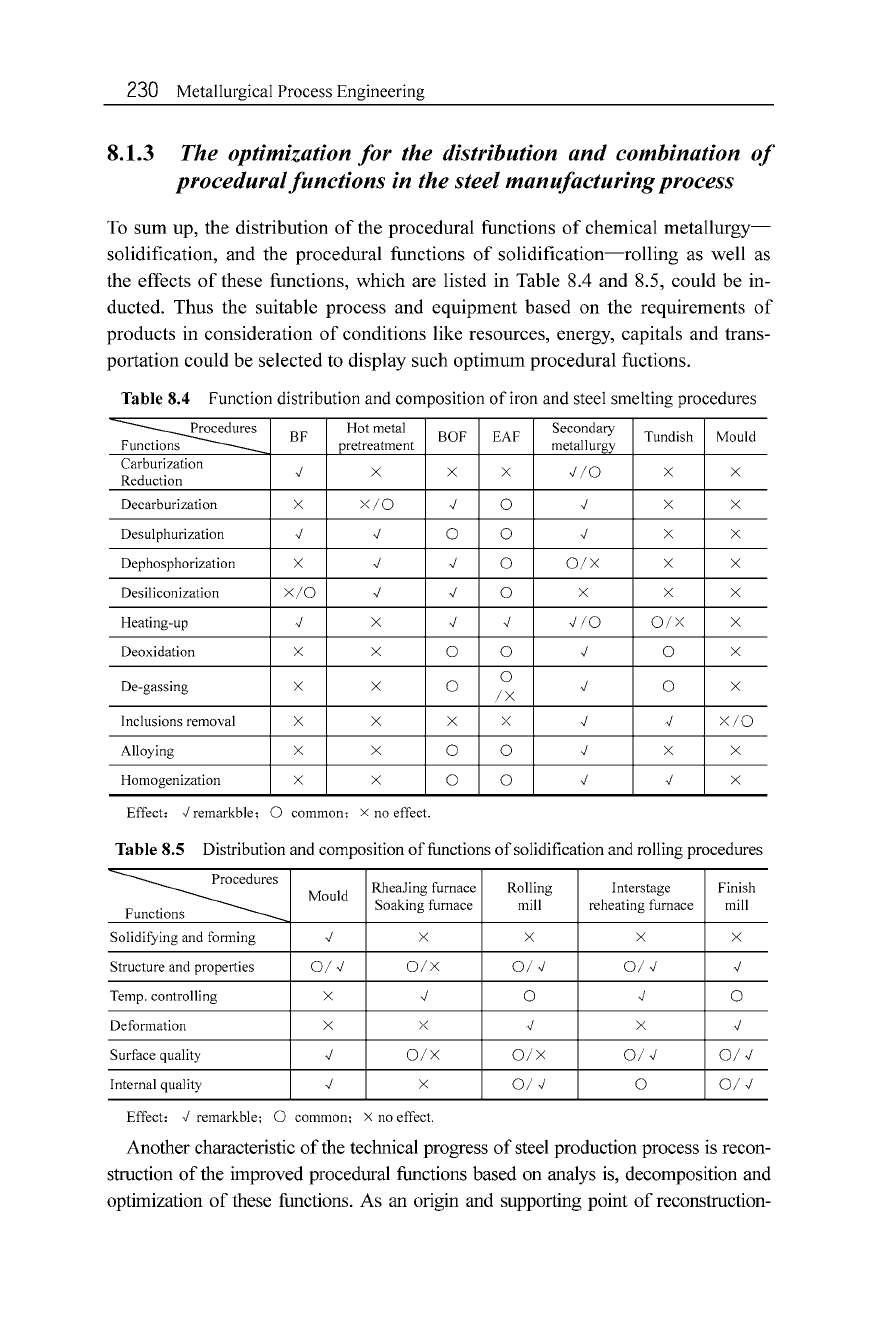
230
Metallurgical Process Engineering
8.1.3 The optimization for the distribution and combination
of
proceduralfunctions in the steel manufacturingprocess
To sum up, the distribution
of
the procedural functions
of
chemical metallurgy-
solidification, and the procedural functions
of
solidification- rolling as well as
the
eff
ects
of
these functions, which are listed in Table 8.4 and 8.5, could be in-
ducted. Thus the suitable process and equipment based on the requirements
of
products in consideration
of
conditions like resources, energy, capitals and trans-
portation could be selected to display such optimum procedural fuctions.
Table 8.4 Function distribution and composition
of
iron and steel smelting procedures
~
BF
Hot metal
BOF EAF
Secondary
Tundish Mould
Functions
pretreatment metallurgy
Carburization
.j
X X
X
.j / O X X
Reduction
Decarburization
X
x
/o
.j
0
.j
X X
Desulphurization
.j .j
0 0
.j
X X
Dephosphorization X
.j .j
0
o
/x
X X
Desiliconization x
/o
.j .j
0
X X X
Heating-up
.j
X
.j .j
.JIO
o
/x
X
Deoxidation X X
0 0
.j
0
X
De-gassing
X X
0
0
.j
0
X
/ X
Inclusions removal
X X X X
.j .j
X
/O
Alloying
X X
0 0
.j
X X
Homogenization X X
0 0
.j .j
X
Effect: .j remarkblc- 0 common : X no effect.
Table 8.5 Distribution and composition
of
functions
of
solidification and rolling procedures
~
RheaJing furnace Rolling Interstage Finish
Mould
Functions
Soaking furnace mill reheating furnace mill
Solidifying and forming
.j
X
X X X
Structure and properties
00
o / x
00 00
.j
Temp. controlling
X
.j
0
.j
0
Deformation
X
X
.j
X
.j
Surface quality
.j
o / x o
/x
00 00
Internal quality
.j
X
00
0
00
Effect: .j remarkble, 0 common : X no effect.
Another characteristic
of
the technical progress of steel production process is recon-
struction of the improved procedural functions based on analys is, decomposition and
optimization
of
these functions. As an origin and supporting point of reconstruction-
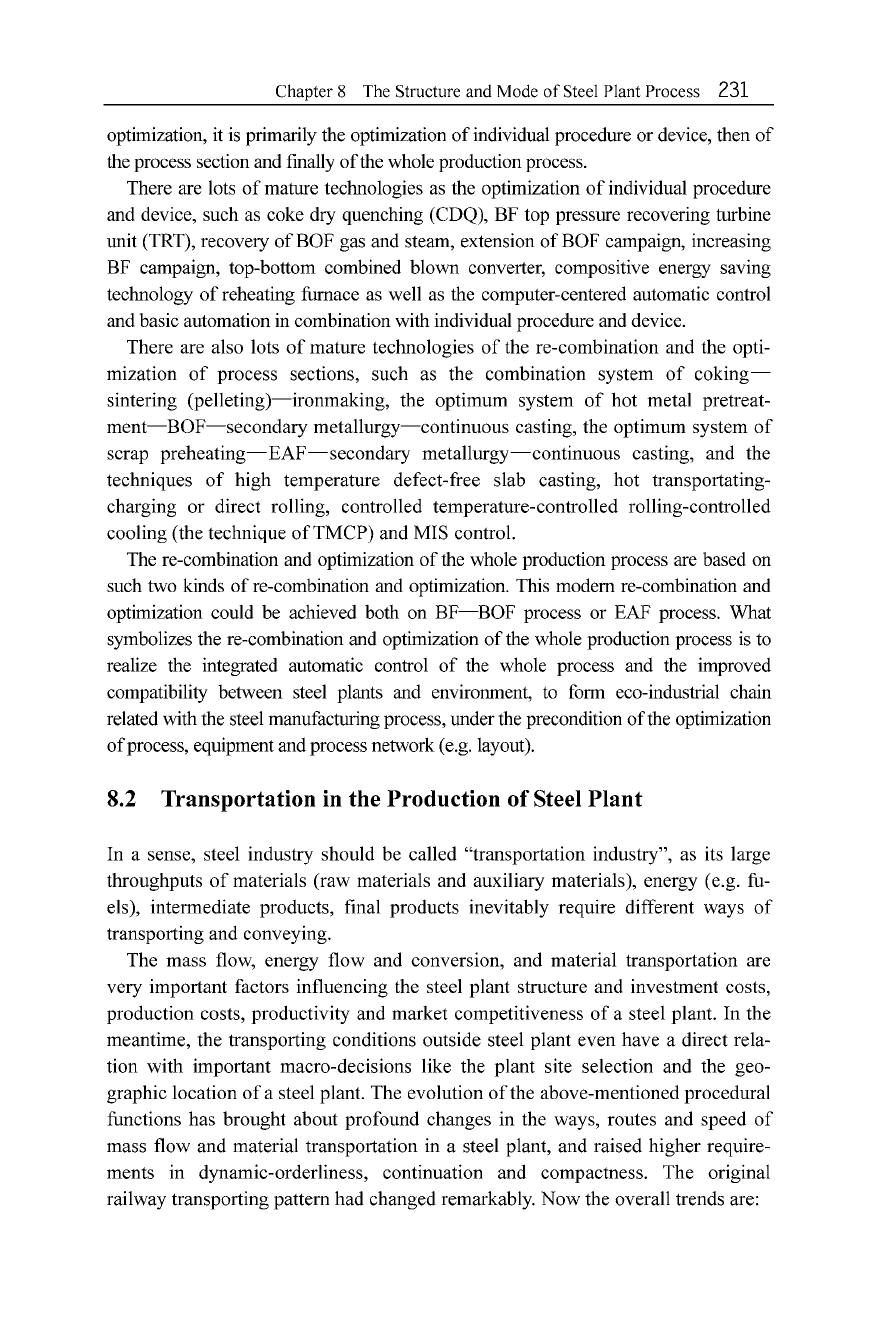
Chapter 8 The Structure and Mode
of
Steel Plant Process
231
optimization,it is primarily the optimization
of
individualprocedure or device,then of
the processsectionand finallyofthe whole productionprocess.
There are lots
of
mature technologies as the optimization
of
individual procedure
and device, such as coke dry quenching (CDQ),
SF
top pressure recovering turbine
unit (TRT), recovery of BOF gas and steam, extension
of
BOF campaign, increasing
BF campaign, top-bottom combined blown converter, compositive energy saving
technology
of
reheating furnace as well as the computer-centered automatic control
and basic automation in combinationwith individualprocedure and device.
There are also lots
of
mature technologies
of
the re-combination and the opti-
mization
of
process sections, such as the combination system
of
coking-
sintering (pelletingj-r-ironmaking, the optimum system
of
hot metal pretreat-
ment
-SOF
-secondary
metallurgy
-continuous
casting, the optimum system
of
scrap preheating
-EAF
-secondary
metallurgy
-continuous
casting, and the
techniques
of
high temperature defect-free slab casting, hot transportating-
charging or direct rolling, controlled temperature-controlled rolling-controlled
cooling (the technique
ofTMCP)
and MIS control.
The re-combination and optimization of the whole production process are based on
such two kinds
of
re-combination and optimization. This modem re-combination and
optimization could be achieved both on
BF-BOF
process or EAF process. What
symbolizes the re-combination and optimization
of
the whole production process is to
realize the integrated automatic control of the whole process and the improved
compatibility between steel plants and environment, to form eco-industrial chain
relatedwith the steel manufacturingprocess, underthe precondition
of
the optimization
of process,equipmentand processnetwork (e.g. layout).
8.2 Transportation in the Production of Steel Plant
In a sense, steel industry should be called "transportation industry", as its large
throughputs
of
materials (raw materials and auxiliary materials), energy (e.g. fu-
els), intermediate products, final products inevitably require different ways
of
transporting and conveying.
The mass flow, energy flow and conversion, and material transportation are
very important factors influencing the steel plant structure and investment costs,
production costs, productivity and market competitiveness
of
a steel plant. In the
meantime, the transporting conditions outside steel plant even have a direct rela-
tion with important macro-decisions like the plant site selection and the geo-
graphic location
of
a steel plant. The evolution
of
the above-mentioned procedural
functions has brought about profound changes in the ways, routes and speed
of
mass flow and material transportation in a steel plant, and raised higher require-
ments in dynamic-orderliness, continuation and compactness. The original
railway transporting pattern had changed remarkably. Now the overall trends are:
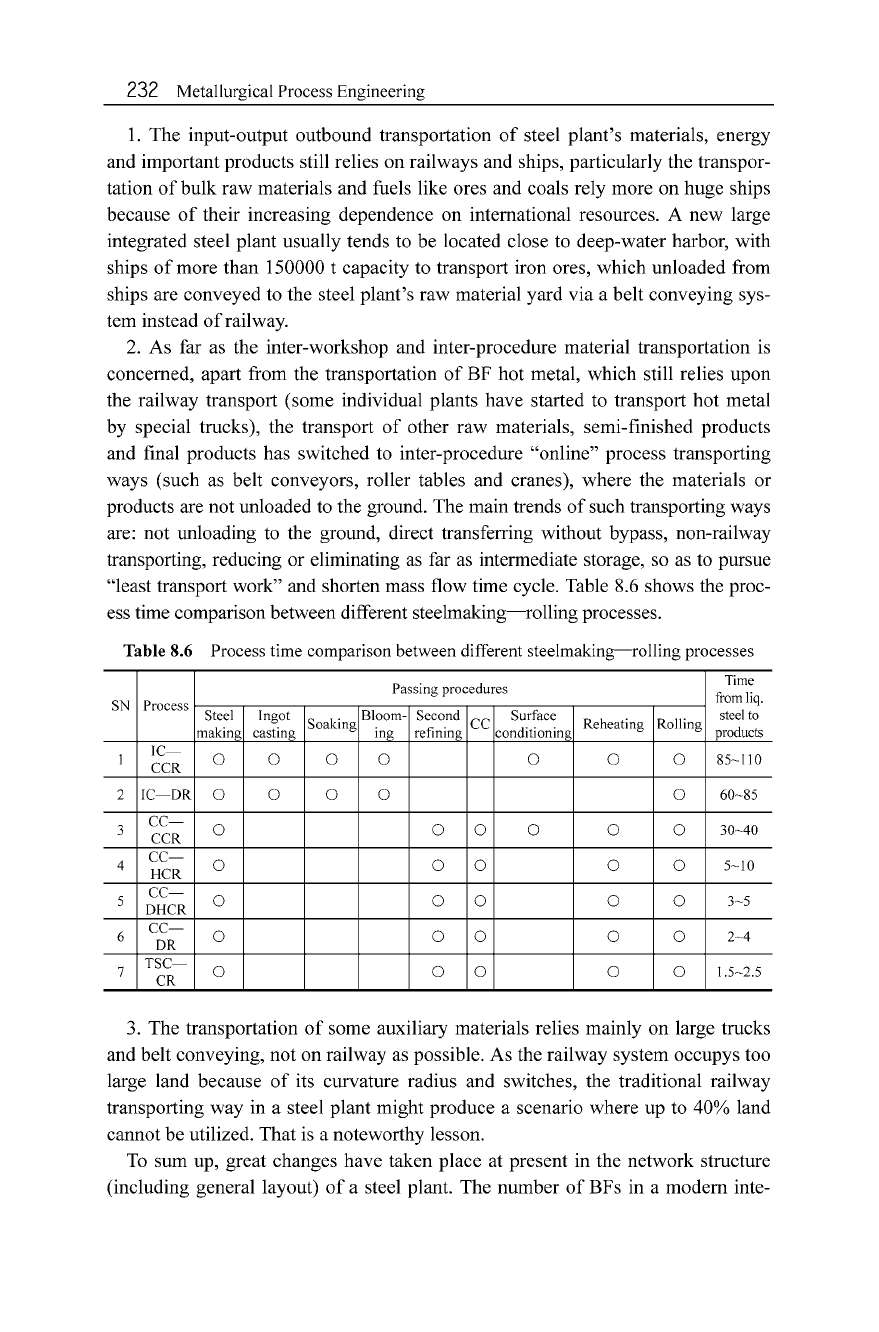
232
Metallurgical Process Engineering
I. The input-output outbound transportation
of
steel plant's materials, energy
and important products still relies on railways and ships, particularly the transpor-
tation of bulk raw materials and fuels like ores and coals rely more on huge ships
because of their increasing dependence on international resources. A new large
integrated steel plant usually tends to be located close to deep-water harbor, with
ships
of
more than 150000 t capacity to transport iron ores, which unloaded from
ships are conveyed to the steel plant's raw material yard via a belt conveying sys-
tem instead of railway.
2. As far as the inter-workshop and inter-procedure material transportation is
concerned, apart from the transportation
of
BF hot metal, which still relies upon
the railway transport (some individual plants have started to transport hot metal
by special trucks), the transport of other raw materials, semi-finished products
and final products has switched to inter-procedure "online" process transporting
ways (such as belt conveyors, roller tables and cranes), where the materials or
products are not unloaded to the ground. The main trends of such transporting ways
are: not unloading to the ground, direct tran
sf
erring without bypass, non-railway
transporting, reducing or eliminating as far as intermediate storage, so as to pursue
"least transport work" and shorten mass flow time cycle. Table 8.6 shows the proc-
ess time comparison between different steelmaking
-ro
lling processes.
Table 8.6 Process time comparison between different steelmaking
-r
olling processes
Passing procedures
li
me
SN Process
fromliq.
Steel Ingot
Soaking
Bloom-
Second
CC
Surface
Reheating Rolling
steel to
making casting
ina
refining conditioning products
1
IC-
0 0 0 0 0 0 0
85-1 10
CCR
2
IC- DR
0 0 0 0 0
60-85
3
CC-
0 0 0 0 0 0
30- 40
CCR
4
CC-
0 0 0 0 0
5- 10
HCR
5
CC-
0 0 0 0 0 3-5
DHCR
6
CC-
0 0 0 0 0
2
-4
DR
7
TSC-
0 0 0 0 0
1.5-2.5
CR
3. The transportation
of
some auxiliary materials relies mainly on large trucks
and belt conveying, not on railway as possible. As the railway system occupys too
large land because of its curvature radius and switches, the traditional railway
transporting way in a steel plant might produce a scenario where up to 40% land
cannot be utilized. That is a noteworthy lesson.
To sum up, great changes have taken place at present in the network structure
(including general layout) of a steel plant. The number of BFs in a modern inte-
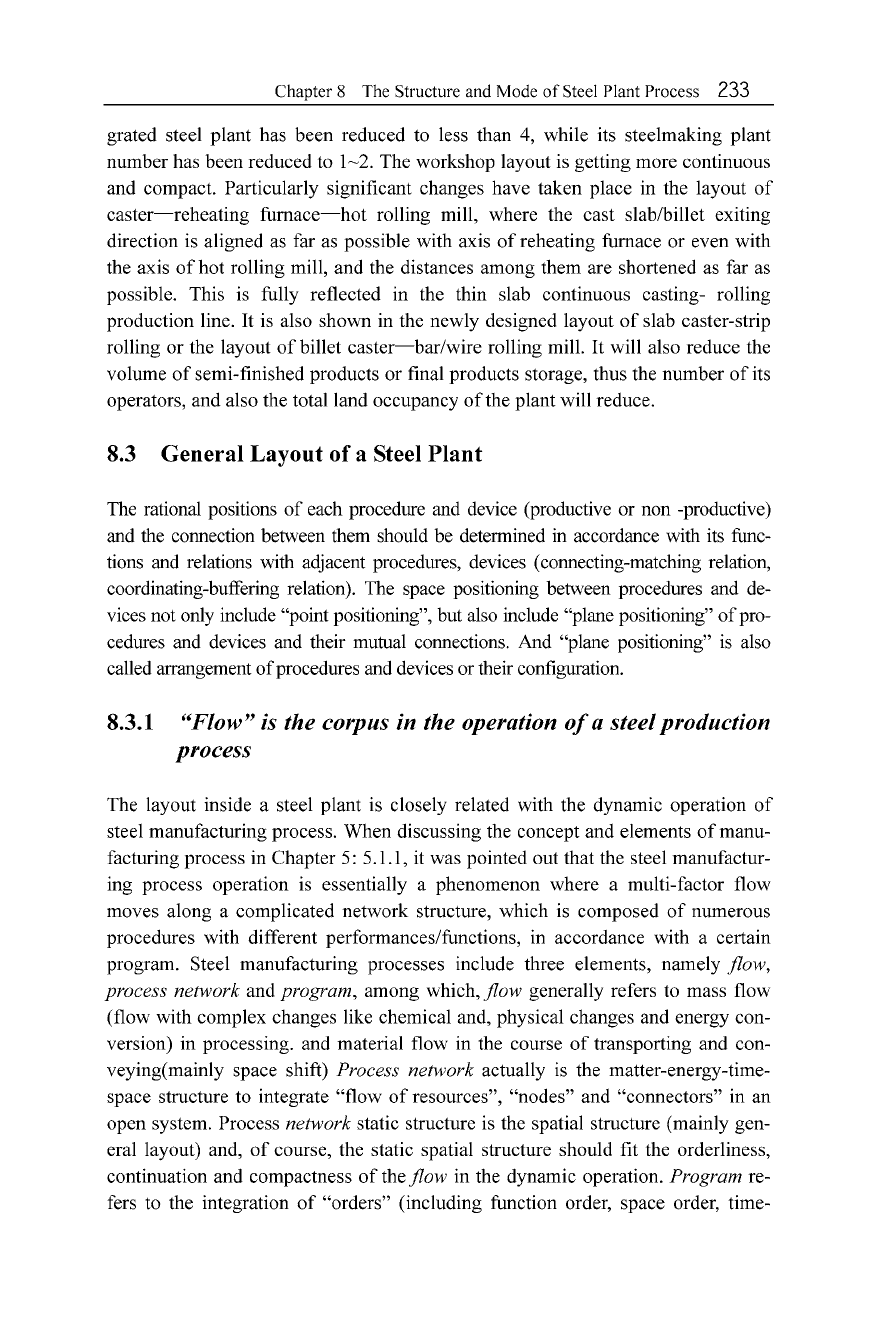
Chapter 8 The Structure and Mode
of
Steel Plant Process
233
grated steel plant has been reduced to less than 4, while its steelmaking plant
number has been reduced to
1
-2
. The workshop layout is getting more continuous
and compact. Particularly significant changes have taken place in the layout
of
caster-reheating
furnace
-hot
rolling mill, where the cast slab/billet exiting
direction is aligned as far as possible with axis
of
reheating furnace or even with
the axis
of
hot rolling mill, and the distances among them are shortened as far as
possible. This is fully reflected in the thin slab continuous casting- rolling
production line.
It is also shown in the newly designed layout
of
slab caster-strip
rolling or the layout
of
billet
caster-bar/wire
rolling mill.
It
will also reduce the
volume
of
semi-finished products or final products storage, thus the number
of
its
operators, and also the total land occupancy
of
the plant will reduce.
8.3 General Layout of a Steel Plant
The rational positions of each procedure and device (productive or non -productive)
and the connection between them should be determined in accordance with its func-
tions and relations with adjacent procedures, devices (connecting-matching relation,
coordinating-buffering relation). The space positioning between procedures and de-
vices not only include"point positioning",but also include"plane positioning"of pro-
cedures and devices and their mutual connections. And "plane positioning" is also
calledarrangementof proceduresand devicesor their configuration.
8.3.1 "Flow" is the corpus in the operation
of
a steel production
process
The layout inside a steel plant is closely related with the dynamic operation
of
steel manufacturing process. When discussing the concept and elements
of
manu-
facturing process in Chapter 5: 5.1.1, it was pointed out that the steel manufactur-
ing process operation is essentially a phenomenon where a multi-factor flow
moves along a complicated network structure, which is composed
of
numerous
procedures with different performances/functions, in accordance with a certain
program. Steel manufacturing processes include three elements, namely flow,
process network and program, among which, flow generally refers to mass flow
(flow with complex changes like chemical and, physical changes and energy con-
version) in processing. and material flow in the course
of
transporting and con-
veying(mainly space shift) Process network actually is the matter-energy-time-
space structure to integrate "flow
of
resources", "nodes" and "connectors" in an
open system. Process network static structure is the spatial structure (mainly gen-
eral layout) and,
of
course, the static spatial structure should fit the orderliness,
continuation and compactness
of
the flow in the dynamic operation. Program re-
fers to the integration
of
"orders" (including function order, space order, time-

234
Metallurgical Process Engineering
characteristic order), and the collection
of
rules, strategies and routes
of
operation.
It
is thus clear that the flow is the corpus
of
process dynamic operation; process
network is the optimized configuration
of
"nodes" and "connectors" in the course
of
flow operation, and the time-space boundary formed by them. Program is a
"software", to drive the optimal operation
of
process.
8.3.2 The importance
of
general layout
A.
The
general layout of a steel
plant
should
represent
the
overall
project
concept of the dynamic operation of the
manufacturing
process
Once determined and implemented, the general layout would form a "solidified"
static network frame, which is difficult to change arbitrarily. The general layout is
the reflection
of
a steel plant's static spatial structure; to a great extent, it is the
norm
of
time-space boundary.
Steel plant's general layout is to configure the spaces (which are occupied by per-
sonnel, machinery, tools and materials) in a most rational and most thorough way in
the process starting from receiving raw materials and fuels through to final product
transporting, and then combine them in an effective way in order to achieve best
economicbenefit and environmental-ecological benefit(Chu, 1995).
Plant layout is virtually a technology used to plan mass flow, energy flow, hu-
man flow and information flow
of
the whole plant, and so a technology used to
form balanced, orderly and highly efficient action to organize the persons and
materials between complicated procedures and various devices.
In planning the material flow-matter flow system in a steel plant, if the variety
and quantity
of
material flow and energy flow are basically fixed, the length
of
route determines the magnitude
of
transportation work. The shorter the route is,
the less the work needs, and accordingly the less the energy consumes. The selec-
tions
of
driving methods and transporting facilities are also related with energy
consumption, then their selections largely depend on economic judgments.
B.
The
steel
plant
should
represent
the concepts
about
"flow" (material flow
and mass flow) to be the core
A highly efficient planning
of
material flow-matter flow is an important prerequi-
site for economic production. If it is effectively arranged for the procedures and
devices according to the material flow-matter flow diagram, all processes would
be operated efficiently (Chu, 1997). Good plant layout would bring about long-
term effects
of
economic operation. The standards raised by Mr. James J. Moore
to assess plant layout (process network) include:
I. the most simplified material flow in production;
2. the least material transporting cost;

Chapter 8 The Structure and Mode
of
Steel Plant Process
235
3. to change process flow sheet in a quickest way;
4. to utilize space in the most effective way;
5. the safest, most comfortable and most pleasing working environment;
6. to avoid unnecessary investment;
7. to arouse the enthusiasm
of
labors.
Plant layout and workshop layout are interdependent. The general layout
of
a plant is
not merely about the optimum arrangement
of
each workshop or procedure more im-
portantly,it is about the optimization
of
the production process
of
the whole plant. As a
result, the mutual coordination
of
matter-energy-time-spacecould be achieved, thus the
material flow-matter flow, driven by energy, can move along the shortest route in the
simplest and quickest way. That means the least transportation work to produce unit
products. For a high temperature production process, short transporting route, short
operation time and small temperature drop
of
materials mean less heat losses, which is
a reflection
of
energy saving. Therefore, the optimization
of
plant general layout and
workshop layout would make it possible for the plant to maintain long-term economic
operation to the greatest extent, this is one
of
the significant prerequisites for the sur-
vival and development
of
a steel plant.
C.
The
general layout of modern steel
plant
should
represent
the progress of
manufacturing
process
In modem steel plants, with the evolution and progress
of
BF-BOF
interface
techniques, with the development
of
such interface techniques as the high - tem-
perature linkage between steelmaking
-secondary
metallurgy
-continuous
cast-
ing-reheating
furnace-rolling
mill, particularly with the development
of
thin
slab continuous casting and rolling process, the plant general layout has taken on
lots
of
new characteristics.
1. Layout between BF
-BOF
. The layout between BF
-BOF
should reflect the
requirements
of
the quickness, buffering and coordination in transporting hot
metal, particularly it should reflect the coordination
of
BF tapping-hot metal
transport with BOF blowing-sequence casting due to development
of
technologies
like BF enlargement and intensified smelting, the diversification
of
hot metal pre-
treatment, as well as BOF intensification. Thus the number
of
BFs could be re-
duced to
2
~4
(particularly
2
~3),
which would promote the simplification
of
times
and ways
of
BF tapping-hot metal output and its fast operation.
Of
course, that re-
quires the rational selection
of
hot metal pretreatment pattern and its rational "plane
positioning" in the layout, and so convenience for dynamics-orderly BOF blowing-
sequence casting. The overall trend is to minimize the distance between BF tapping
and BOF charging, the time for Transporting hot metal and the number
of
iron la-
dIes, to charge hot metal correctly and directly into BOF, and to maximize the speed
of
returning the empty ladle.
2. High
temperature
heat
linkage
between
BOF
-secondary
metallurgy
-
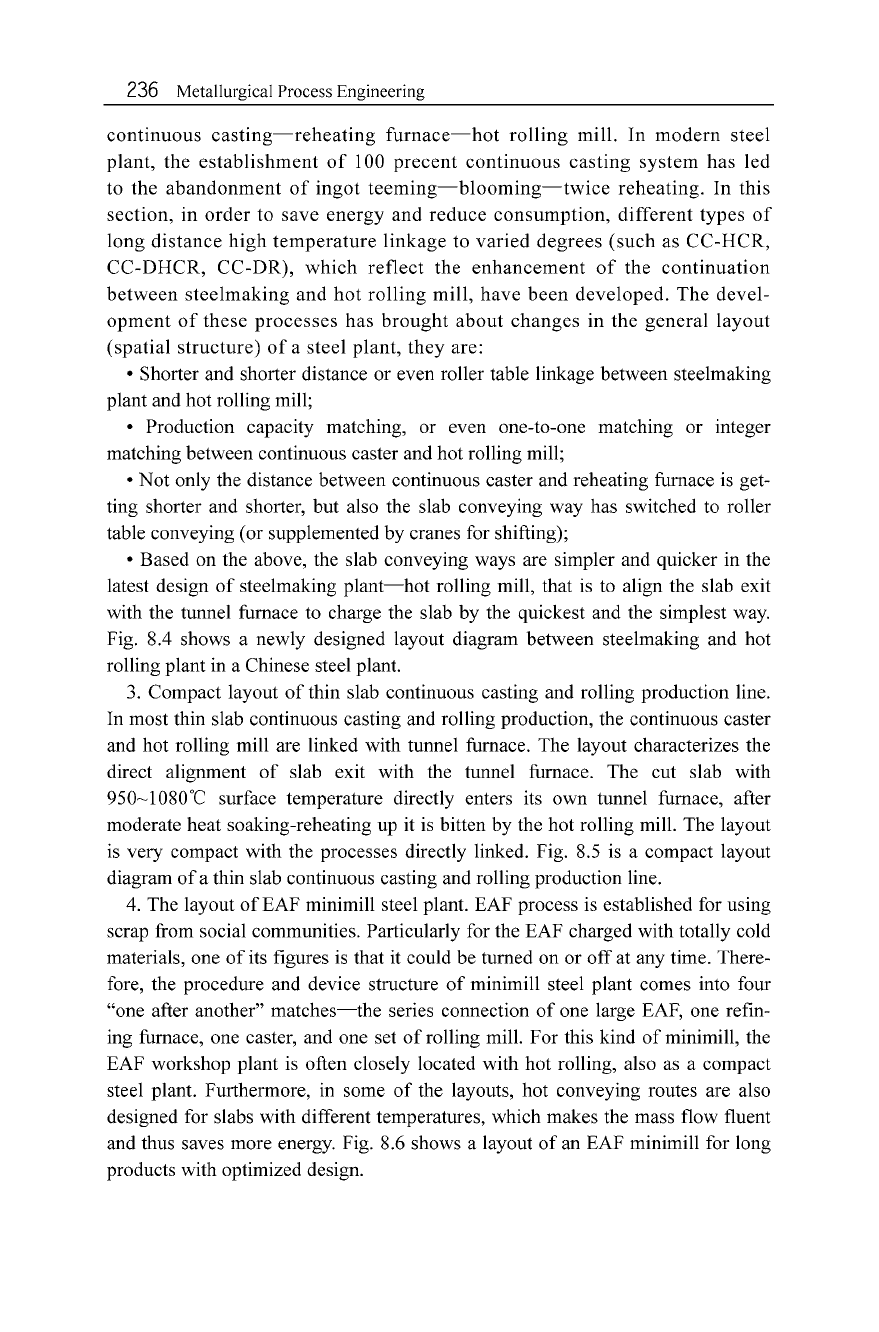
236
Metallurgical Process Engineering
continuous
casting-reheating
furnace-hot
rolling mill. In modern steel
plant, the establishment
of
100 precent continuous casting system has led
to the abandonment
of
ingot teeming
-blooming
-twice
reheating. In this
section, in order to save energy and reduce consumption, different types
of
long distance high temperature linkage to varied degrees (such as CC-HCR,
CC-DHCR, CC-DR), which reflect the enhancement
of
the continuation
between steelmaking and hot rolling mill, have been developed. The devel-
opment
of
these processes has
brought
about changes in the general layout
(spatial structure)
of
a steel plant, they are:
• Shorter and shorter distance or even roller table linkage between steelmaking
plant and hot rolling mill;
• Production capacity matching, or even one-to-one matching or integer
matching between continuous caster and hot rolling mill;
• Not only the distance between continuous caster and reheating furnace is get-
ting shorter and shorter, but also the slab conveying way has switched to roller
table conveying (or supplemented by cranes for shifting);
• Based on the above, the slab conveying ways are simpler and quicker in the
latest design
of
steelmaking plant
-hot
rolling mill, that is to align the slab exit
with the tunnel furnace to charge the slab by the quickest and the simplest way.
Fig. 8.4 shows a newly designed layout diagram between steelmaking and hot
rolling plant in a Chinese steel plant.
3. Compact layout
of
thin slab continuous casting and rolling production line.
In most thin slab continuous casting and rolling production, the continuous caster
and hot rolling mill are linked with tunnel furnace. The layout characterizes the
direct alignment
of
slab exit with the tunnel furnace. The cut slab with
950
~
1080
°C
surface temperature directly enters its own tunnel furnace, after
moderate heat soaking-reheating up it is bitten by the hot rolling mill. The layout
is very compact with the processes directly linked. Fig. 8.5 is a compact layout
diagram
of
a thin slab continuous casting and rolling production line.
4. The layout
ofEAF
minimill steel plant. EAF process is established for using
scrap from social communities. Particularly for the EAF charged with totally cold
materials, one
of
its figures is that it could be turned on or
off
at any time. There-
fore, the procedure and device structure
of
minimill steel plant comes into four
"one after another" matches
-the
series connection
of
one large EAF, one refin-
ing furnace, one caster, and one set
of
rolling mill. For this kind
of
minimill, the
EAF workshop plant is often closely located with hot rolling, also as a compact
steel plant. Furthermore, in some
of
the layouts, hot conveying routes are also
designed for slabs with different temperatures, which makes the mass flow fluent
and thus saves more energy. Fig. 8.6 shows a layout
of
an EAF minimill for long
products with optimized design.

N
W
-....J
-J
:;-
(l)
~
2
$:l.
e
<i1
"
:l
0-
3:::
o
0-
(l)
o
.."
en
it
~
-0
;;-
a
-0
a
()
(l)
V>
V>
n
:;-
"
"S
(l)
...
00
8 9765
Slabpiling
area
Slabpilingarea
Slabrun-outtable
4
Maintenance
area
~
~
.
~
.
laiiiiiiai!
'0
'0
OIl
"
E]
E
E
::<
C/l
Fig.8.4 Layout
of
newly designed steelmaking workshop and hot rolling mill in a steel plant in
China
I
-RH;2
-LF;3
-BOF;4
-Ca
ster;5
-Reheating
furnace;6- Edgemill:
7
-Roughing
mill;8
-F
inishing mill;9- Coiler
OIl
"
:§
'5
.D
'2
E
o
o
"
'8
~
~
s
c
ra
p
c
a
r
2
